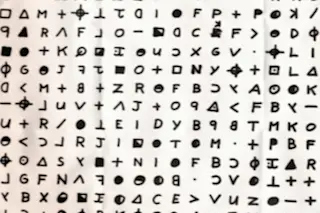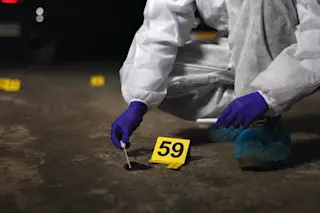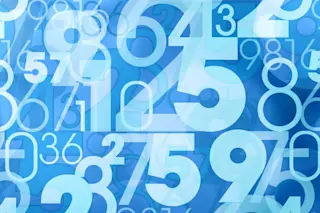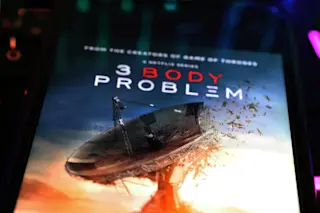Key Takeaways on the Zodiac Killer’s Cipher
In the late 1960s, a serial killer self-identifying as “the Zodiac” killed at least five people in Northern California and claimed to have murdered more. The identity of the Zodiac Killer remains unknown.
The Zodiac Killer sent four coded messages in total to the San Francisco Chronicle in 1969 and 1970. The first had 408 characters and was cracked in a week. The recently solved Z340 cipher was the second. After those, the killer sent two very short ciphers, one with 13 characters and the other with only 32.
This case has remained one of the most famous unsolved mysteries in the history of American criminal investigations.
Few cases have captured the public's imagination and baffled investigators quite like the Zodiac Killer. For decades, this unidentified serial murderer taunted law enforcement and the public alike with cryptic messages and ciphers, leaving a trail of terror in his wake.
One of the most infamous aspects of the Zodiac's sinister saga was the series of letters he sent to local newspapers, in which he claimed responsibility for his gruesome crimes and taunted authorities with cryptograms. Among these letters, one stood out as a tantalizing puzzle that would endure for years – the Zodiac Killer letter that finally got decoded.
Wonder no more, true-crime aficionados.
Who Was the Mysterious Zodiac Killer?
In the late 1960s, a serial killer self-identifying as “the Zodiac” killed at least five people in Northern California and claimed to have murdered more. In November 1969, the Zodiac Killer sent a card to the San Francisco Chronicle containing a 340-character secret message, also known as the Z340, that for more than 50 years went unsolved by detectives, cryptography experts, amateur sleuths, and curious others.
After months of crunching code, three researchers on three different continents announced that they’d finally decoded the Z340 message. Further bolstering the claim, experts at the FBI verified the solution (and even tweeted about it).
Read More: What is True Crime? A Not So Strange Addiction
Decades of Trying to Crack the Zodiac Killer's Code
The encrypted message has brought decades of speculation, conspiracy theories, and guesswork to a dramatic close.
“It took a lot of computational effort, and it’s been a real source of frustration for a lot of people,” says computer programmer David Oranchak in Roanoke, Virginia, who has a background in cryptography and coordinated the effort.
He’s spent years fielding theories from misguided, would-be sleuths about the meaning of the 340-character code and the identity of its author. “So many people conjure coincidences out of thin air, and the more coincidences they generate, the stronger their evidence.”
“This cipher has always had such a target on its back,” says Sam Blake, an applied mathematician at the University of Melbourne who worked with Oranchak.
Read More: Top 5 Pieces of Forensic Evidence Used to Solve a Crime
Who Cracked the Z340 Zodiac Killer Code?
Although the codebreakers involved had each been working on the cipher for years, the successful joint effort began in 2018 when Oranchak delivered a talk about the cipher at the annual meeting of the American Cryptogram Association in Asheville, North Carolina. He posted the talk on YouTube where, predictably, it elicited hundreds of comments, many of which came from people who (erroneously) claimed they’d already solved it.
But one person stood out: Blake. He responded to Oranchak’s talk with mathematical ideas about how to approach a code that includes both homophonic substitution — in which one letter might be swapped for more than one symbol — and transposition — in which letters are reordered in a systematic way. Oranchak and Blake began corresponding and eventually generated hundreds of thousands of possible ways to read the code.
To make sense of those, Oranchak brought in Jarl van Eycke, a Belgian warehouse worker and codebreaker who’d written AZdecrypt, software used for decoding homophonic substitutions. Van Eycke used an updated version of his software to churn through the possibilities. “Jarl just smashed it out of the park,” Blake says. In late November and early December 2020, the trio reprocessed their previous results, this time looking for words and phrasing characteristic of other writings by Zodiac.
And they struck gold. Van Eycke’s software spit out two phrases: trying to catch me and gas chamber. They fixed those phrases in the software, ran it again, and more words like paradice [sic] and slaves began to appear. Finally, in early December, they had the message in total. Notably, the message included “that wasn’t me on the TV show,” referencing a call-in news show that had aired just days before the Chronicle received the cipher in 1969.
Read More: Forensic Psychology: Crime, Investigation and Advising
The FBI Confirms the Zodiac Cipher Was Solved
Oranchak sent their solution to contacts at the FBI, and by the end of 2020, the FBI had verified the methodology and results. In March 2021, Blake wrote about how he’d used Mathematica, a math software package, for his part, and in January, van Eycke made headlines again when he cracked an unsolved 386-year-old code composed by a Dutch scientist.
Cracking the 340-character cipher was so computationally heavy, says Oranchak, that no one in 1969 could likely have decoded the Zodiac’s message — which suggests the killer didn’t know just how difficult a code he’d created. In addition, he notes that today’s codes, like the ones that secure smartphone apps or transmit information online, would never fall to such a brute force effort like the one used by Oranchak and his collaborators.
“They’re just not amenable to this kind of attack,” he says. “The Zodiac cipher was almost certainly constructed by pencil and paper, but it was complex enough that it survived attacks for 51 years.”
Read More: Cracking the Cold Case of a 1000-Year-Old Mummy Murder
Was the Zodiac Killer Ever Found?
The identity of the Zodiac Killer remains unknown. This case has remained one of the most famous unsolved mysteries in the history of American criminal investigations. The Zodiac Killer's letters were designed to confuse, mislead, and challenge investigators, making it exceptionally difficult to pinpoint his identity and location.
The Zodiac sent four coded messages in total to the paper in 1969 and 1970. The first had 408 characters and was cracked in a week. The recently solved 340-character cipher was the second. After those, the killer sent two very short ciphers, one with 13 characters and the other with only 32. In January 2021, an engineer in France claimed to have solved those, but Blake is doubtful. “They’re both too short to have a unique solution,” he says
Read More: 5 International Serial Killers Who Will Make Your Skin Crawl
Article Sources
Our writers at Discovermagazine.com use peer-reviewed studies and high-quality sources for our articles, and our editors review for scientific accuracy and editorial standards. Review the sources used below for this article:
Arxiv. The Solution of the Zodiac Killer’s 340-Character Cipher
Biography. Zodiac Killer
Cryptographer. David Oranchak
Applied mathematician at the University of Melbourne. Sam Blake
Stephen Ornes is a science writer in Nashville, Tennessee, who covers math, physics, astronomy and cancer research.















